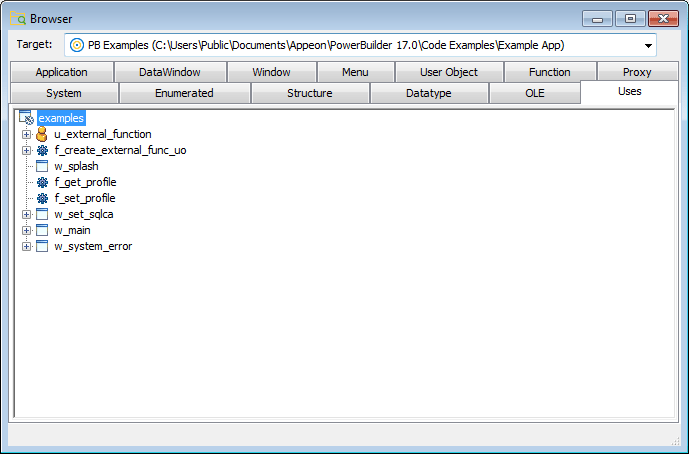If you are working with an application that references one or more objects in an application-level script, you can look at the application's structure in the Browser.
To display the application's structure:
-
Click the Browser button on the PowerBar.
-
In the Browser, select the Uses tab page and select Expand All from the Application object's pop-up menu.
PowerBuilder expands the display to show all the global objects that are referenced in a script for the Application object. You can expand the display further as needed.
The Browser's Uses tab page shows global objects that are referenced in your application. It shows the same types of objects that you can see in the Library painter. It does not show entities that are defined within other objects, such as controls and object-level functions.
The Browser displays the following types of references when the Application object is expanded.
Objects referenced in painters
These are examples of objects referenced in painters:
-
If a menu is associated with a window in the Window painter, the menu displays when the window is expanded.
-
If a DataWindow object is associated with a DataWindow control in the Window painter, the DataWindow object displays when the window is expanded.
-
If a window contains a custom user object that includes another user object, the custom user object displays when the window is expanded, and the other user object displays when the custom user object is expanded.
Objects directly referenced in scripts
These are examples of objects referenced in scripts:
-
If a window script contains the following statement, w_continue displays when the window is expanded:
Open(w_continue)
Which referenced windows display in the Browser
Windows are considered referenced only when they are opened from within a script. A use of another window's property or instance variable will not cause the Browser to display the other window as a reference of the window containing the script.
-
If a menu item script refers to the global function f_calc, f_calc displays when the menu is expanded:
f_calc(EnteredValue)
-
If a window uses a pop-up menu through the following statements, m_new displays when the window is expanded:
m_new mymenu mymenu = create m_new mymenu.m_file.PopMenu(PointerX(), PointerY())
The Browser does not display the following types of references.
Objects referenced through instance variables or properties
These are examples of objects referenced through instance variables or properties:
-
If w_go has this statement (and no other statement referencing w_emp), w_emp does not display as a reference for w_go:
w_emp.Title = "Managers"
Objects referenced dynamically through string variables
These are examples of objects referenced dynamically through string variables:
-
If a window script has the following statements, the window w_go does not display when the window is expanded. The window w_go is named only in a string:
window mywin string winname = "w_go" Open(mywin,winname)
-
If the DataWindow object d_emp is associated with a DataWindow control dynamically through the following statement, d_emp does not display when the window containing the DataWindow control is expanded:
dw_info.DataObject = "d_emp"



